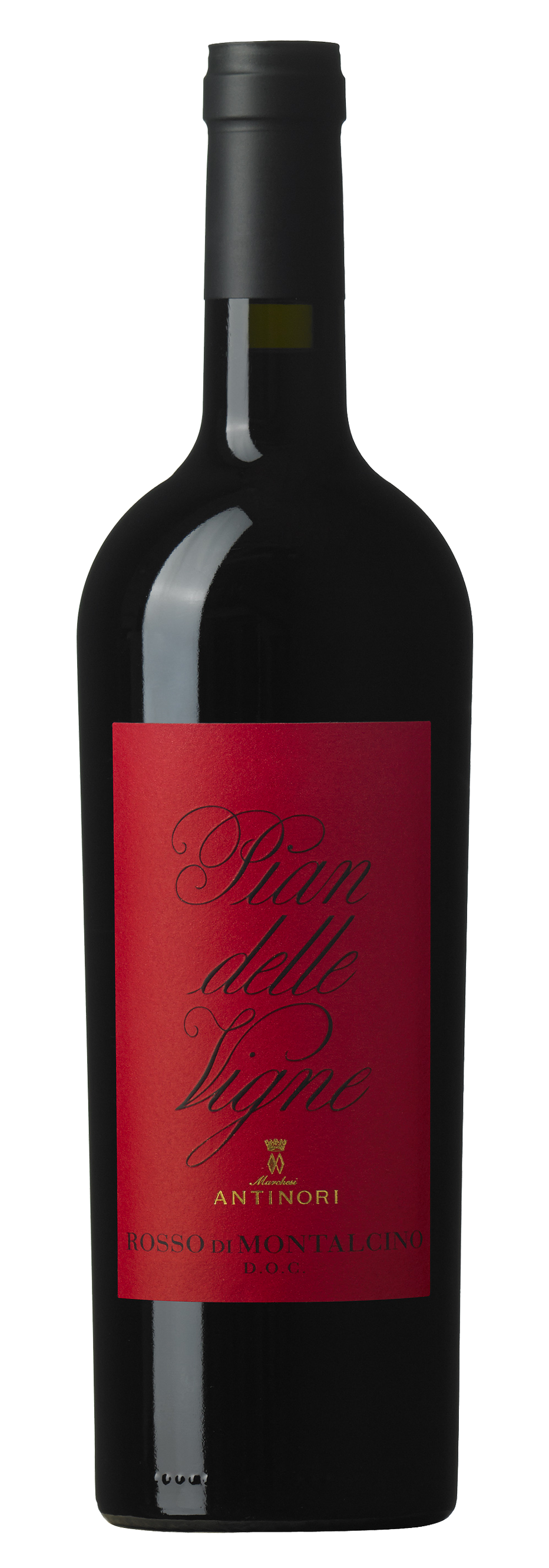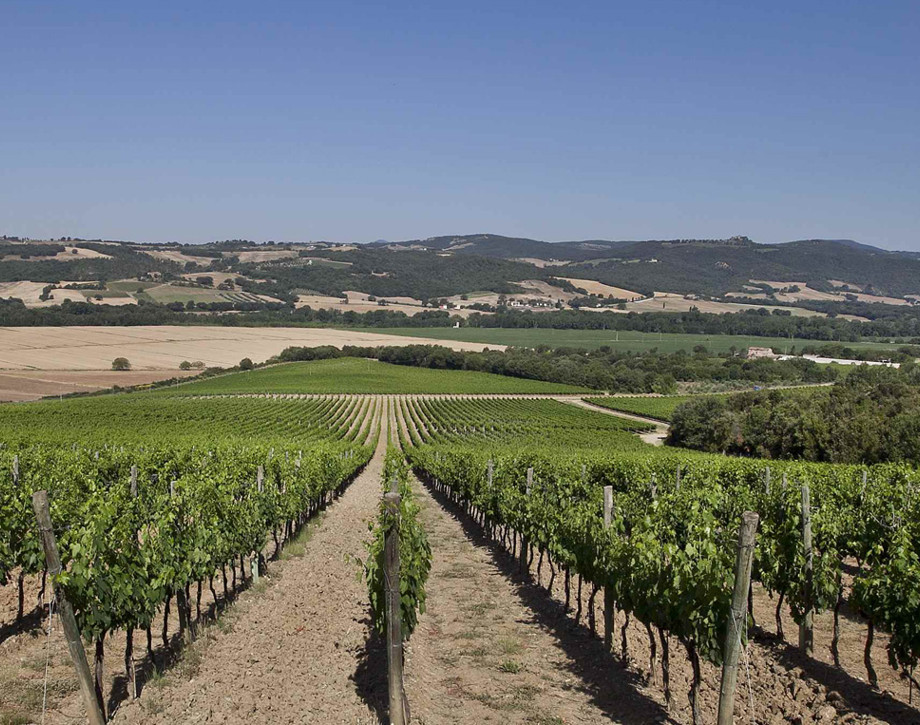Pian delle Vigne

Climate
The 2016 vintage was characterized by a winter which, on the whole, saw little rainfall and by a mild spring. These climatic conditions favored a slightly early bud break and flowering, balanced by a regular epoch of bud set. The summer was marked by temperatures above normal seasonal averages, particularly during the months of July and August. Light rainfall during September and the consequent fall in temperatures assisted the grapes in achieving full ripeness in an optimal fashion, giving the Sangiovese a surprising freshness along with balanced and supple tannins. The picking of the Sangiovese grapes to be used for the Rosso di Montalcino took place during the second half of the month of September.
Vinification
Upon arriving in the cellars, the grapes were destemmed and lightly pressed and then went into stainless steel tanks to be fermented at temperatures held to approximately 77° Fahrenheit (25° centigrade) in order to fully conserve their aromatic patrimony; the fermentation lasted from eight to ten days. At the end of the malolactic fermentation, the wine went into large oak casks where it was aged for a period of approximately twelve months.
Historical Data
Pian del Vigne estate, located 3.5 miles (6 kilometers) to the southwest of the town of Montalcino, takes its name from a characteristic 19th century railroad station situated within the confines of the estate. The property consists of 460 total acres (184 hectares), 160 of which (65 hectares) are planted to vines with generally a south-western exposure at an altitude of 430 feet (130 meters) above sea level. Pian delle Vigne is the personal and profound interpretation on the part of Marchesi Antinori of a traditional prestigious wine such as Brunello di Montalcino. The estate has belonged to the Antinori family since 1995, the year of the first vintage of the Pian delle Vigne Brunello. The Pian delle Vigne Rosso di Montalcino aims to fully bring out the fragrance of pure Sangiovese, the historic grape variety of Montalcino. The vineyards are situated on calcareous clay soils which create a wine which is fresh, mineral in character, and excellent drinking.
Tasting Notes
The wine is an intense ruby red in color and its nose is dominated by notes of such ripe red fruit as wild cherries and raspberries given an additional complexity by hints of violets and dog roses, spices, and the characteristic herbs of Mediterranean brush land. The flavors are fresh and vibrant with supple and silky tannins. On the aftertaste, the notes of such ripe red fruit as red currants and raspberries fuse with light balsamic sensations to compose a long and savory finish.
Awards
James Suckling 91/100 USA

The Wine
This wine accentuates the pleasant freshness of the Sangiovese grape, Montalcino’s historic variety. The vineyard’s soil composition is calcareous-clay that allows Rosso di Montalcino to develop its characteristic freshness, minerality and finish.

Climate
The 2016 vintage was characterized by a winter which, on the whole, saw little rainfall and by a mild spring. These climatic conditions favored a slightly early bud break and flowering, balanced by a regular epoch of bud set. The summer was marked by temperatures above normal seasonal averages, particularly during the months of July and August. Light rainfall during September and the consequent fall in temperatures assisted the grapes in achieving full ripeness in an optimal fashion, giving the Sangiovese a surprising freshness along with balanced and supple tannins. The picking of the Sangiovese grapes to be used for the Rosso di Montalcino took place during the second half of the month of September.
Vinification
Upon arriving in the cellars, the grapes were destemmed and lightly pressed and then went into stainless steel tanks to be fermented at temperatures held to approximately 77° Fahrenheit (25° centigrade) in order to fully conserve their aromatic patrimony; the fermentation lasted from eight to ten days. At the end of the malolactic fermentation, the wine went into large oak casks where it was aged for a period of approximately twelve months.
Historical Data
Pian del Vigne estate, located 3.5 miles (6 kilometers) to the southwest of the town of Montalcino, takes its name from a characteristic 19th century railroad station situated within the confines of the estate. The property consists of 460 total acres (184 hectares), 160 of which (65 hectares) are planted to vines with generally a south-western exposure at an altitude of 430 feet (130 meters) above sea level. Pian delle Vigne is the personal and profound interpretation on the part of Marchesi Antinori of a traditional prestigious wine such as Brunello di Montalcino. The estate has belonged to the Antinori family since 1995, the year of the first vintage of the Pian delle Vigne Brunello. The Pian delle Vigne Rosso di Montalcino aims to fully bring out the fragrance of pure Sangiovese, the historic grape variety of Montalcino. The vineyards are situated on calcareous clay soils which create a wine which is fresh, mineral in character, and excellent drinking.
Tasting Notes
The wine is an intense ruby red in color and its nose is dominated by notes of such ripe red fruit as wild cherries and raspberries given an additional complexity by hints of violets and dog roses, spices, and the characteristic herbs of Mediterranean brush land. The flavors are fresh and vibrant with supple and silky tannins. On the aftertaste, the notes of such ripe red fruit as red currants and raspberries fuse with light balsamic sensations to compose a long and savory finish.
Awards
James Suckling 91/100 USA

Tenuta Pian delle Vigne
The Pian Delle Vigne estate is located 6 kilometers (3.5 miles) southwest of Montalcino. Its name comes from the eponymous area where a characteristic nineteenth century railway station is located. Pian delle Vigne stretches out over an area of 184 hectares (454 acres) of which 65 hectares (160 acres) are planted with vineyards that grow at an altitude of approximately 130 meters (426 feet) above sea level and enjoy a southeastern exposure. The estate’s namesake wine, Pian delle Vigne, represents Marchesi Antinori’s deeply personal interpretation of a prestigious and traditional wine such as Brunello di Montalcino. The Antinori family acquired the estate in 1995, the same year the first Brunello Pian delle Vigne was harvested.

Soil
Soil composition is essentially clay, calcareous and rich in very fine gravel.
















